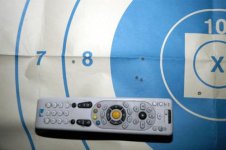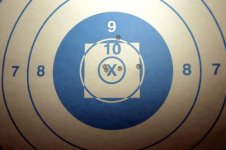G
Greg Culpepper
Guest
anybody shoot Sierras seriously?
amamnn,
I bought 3000 of the 107 SMKs to shoot in F-Class and for my step daughters's 600 yd BR shooting to save cost compared to Clinch Rivers for the less demanding applications. Rebecca had to have a vitrectomy in her shooting eye and gave shooting up for awhile. At the last match at Piedmont in 2008 I shot her rifle (newly chambered take off barrel in a no turn neck 6BR for economy an simplicity) with the SMKs and got the HG agg and 2nd place group in LG. In 2009 I shot only three 600 yd matches (all at Piedmont and again with her rifle) and got enough club points for 4th and 11th place in IBS SOY. That last (August) match at Piedmont those Sierras got 1st for HG score, 1st LG group and 1st LG score. As you know, Piedmont is a tough crowd and two weeks later my NC colleagues Sam, Mike and Rodney went to Pierre where they finished 1st, 3rd and 4th at the IBS Nats and Sam of course clinched SOY for the second year in row.
The SMKs 107s will run with the big dogs. The attached photos are the most recent 600 yd and 1000 yd IBS targets I shot with those bullets also with that same rifle. Chris Collins was pulling the target next to mine at Butner and reported the the first three shots on the 1K target made the 1.2" wad in the middle. Bless those fishtailing winds!
These Sierras are the most uniform bullets that I have ever measured (I've measured most) and clearly are not mixed from more than one die. I've shot them measured but unsorted (there is nothing to sort) but more often than not pointed with a Whidden die. I haven't done any comparative testing against other bullets or even tuned this combo. They shot good the first time I tried them and they still do. After 1400 rounds I'm still shooting the exact load that my gunsmith Mark King suggested when he sent the rechambered barrel back to me. It's my first 6BR.
Hope this helps answer your question,
Greg
I'm not being a smart ass, really, I would like to know if anyone who shoots BR at all seriously these days uses Sierra or Hornady or any of the Mass produced bullets in competition. I was told long ago, that the bullets I was using (Sierra MK) and I found to be very good in service rifle matches, were made three at a time from three different dies, and hence not the best for BR.
Now, say what you want about the NRA, but they can sometimes be a wonderful source of information. On one of the American Rifleman TV shows, they took a trip through the Sierra manufacturing facility. They showed Bullets being jacketed and sent down the chute for boxing. There on the screen in close up were three dies stamping out bullets and the bullets all being mixed together bound for the lil green boxes we all know. I do use Sierra MKs for other applications and have checked them closely with my Sinclair hex nut comparator. They do tend to fall into three rough groups as far as base to ogive, not really a lot different, but more than I like to see for BR. It will be interesting to see some match results and equipment lists when the new AR class gets going, though. I do believe Sierra has the most AR shooters presently.
amamnn,
I bought 3000 of the 107 SMKs to shoot in F-Class and for my step daughters's 600 yd BR shooting to save cost compared to Clinch Rivers for the less demanding applications. Rebecca had to have a vitrectomy in her shooting eye and gave shooting up for awhile. At the last match at Piedmont in 2008 I shot her rifle (newly chambered take off barrel in a no turn neck 6BR for economy an simplicity) with the SMKs and got the HG agg and 2nd place group in LG. In 2009 I shot only three 600 yd matches (all at Piedmont and again with her rifle) and got enough club points for 4th and 11th place in IBS SOY. That last (August) match at Piedmont those Sierras got 1st for HG score, 1st LG group and 1st LG score. As you know, Piedmont is a tough crowd and two weeks later my NC colleagues Sam, Mike and Rodney went to Pierre where they finished 1st, 3rd and 4th at the IBS Nats and Sam of course clinched SOY for the second year in row.
The SMKs 107s will run with the big dogs. The attached photos are the most recent 600 yd and 1000 yd IBS targets I shot with those bullets also with that same rifle. Chris Collins was pulling the target next to mine at Butner and reported the the first three shots on the 1K target made the 1.2" wad in the middle. Bless those fishtailing winds!
These Sierras are the most uniform bullets that I have ever measured (I've measured most) and clearly are not mixed from more than one die. I've shot them measured but unsorted (there is nothing to sort) but more often than not pointed with a Whidden die. I haven't done any comparative testing against other bullets or even tuned this combo. They shot good the first time I tried them and they still do. After 1400 rounds I'm still shooting the exact load that my gunsmith Mark King suggested when he sent the rechambered barrel back to me. It's my first 6BR.
Hope this helps answer your question,
Greg
Attachments
Last edited by a moderator:



